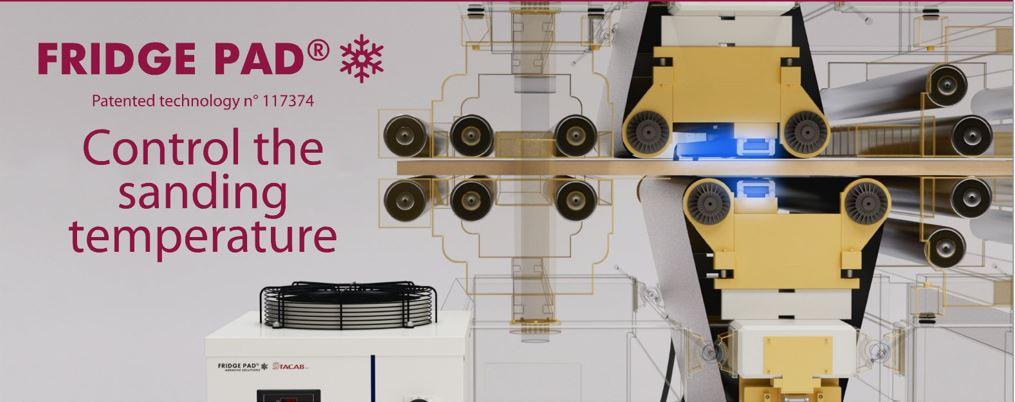Sumicarol
News


FRIDGE PAD® - Better Performance, Less Consumption
FRIDGE PAD®
FRIDGE PAD® is an active cooling system designed to be integrated into Medium Density Fiberboard (MDF) sanding machines. It is installed specifically in the quick-change pad insertion area of the sander, where it incorporates a duralumin (high-strength aluminum alloy with excellent thermal conductivity) component that is continuously cooled. By keeping the temperature low at this critical point of the sanding process, FRIDGE PAD® optimizes machine performance in three key areas: reduction of electrical consumption, improvement of surface finish, and enhancement of operational safety. Below is a detailed description of these benefits, aimed at industrial professionals such as maintenance managers, process engineers, or equipment manufacturers.
Reduction of Electrical Consumption
In industrial sanding processes, a significant portion of the energy consumed by the machine is lost as heat due to friction. This residual heat not only represents wasted energy but also forces the motor to work harder to maintain sanding efficiency. The FRIDGE PAD® system tackles this issue by extracting the heat generated in the sanding pad area through its actively cooled duralumin component. By rapidly dissipating frictional heat, the proportion of energy diverted to heating components and surrounding air is reduced, allowing more energy to be used for effective abrasive cutting on the workpiece.
This localized cooling directly impacts energy consumption: the sander motor encounters less thermal and mechanical resistance, resulting in lower power demand for the same level of material removal. In other words, the sanding machine operates more energy-efficiently. Technical studies on sanding processes confirm that minimizing heat losses improves process efficiency. In practice, the installation of FRIDGE PAD® contributes to reduced electricity consumption, lower operational costs, and a more sustainable process—without sacrificing performance.
Improved Surface Finish
Controlling temperature in the sanding zone not only saves energy but also improves the quality of the surface finish on MDF boards. In conventional sanding, excessive heat can negatively impact both the material and the abrasive: high temperatures tend to soften the resins and binders in MDF, causing dust to stick to the abrasive paper (clogging) and leading to scorched or polished areas on the surface. These effects result in an uneven finish with streaks, unwanted gloss, or texture variations.
With FRIDGE PAD®, the temperature in the sanding pad area remains significantly lower, even during prolonged operations. This thermal control offers multiple advantages for surface quality:
- Reduced abrasive clogging: By avoiding overheating, wood fibers and released resins do not melt or adhere as easily to the abrasive. The sanding belt stays cleaner longer, maintaining its cutting power and producing a more uniform finish.
- Prevention of thermal damage to MDF: Heat dissipation prevents burn marks or discoloration caused by excessive friction. The result is a finer, more consistent finish across the entire piece.
- Stable sanding conditions: The cooled duralumin component also acts as a thermal stabilizer. By maintaining a constant temperature at the abrasive-material interface, sanding parameters (such as pad hardness, abrasive response, and contact pressure) vary less throughout the work cycle.
In short, FRIDGE PAD® functions as a thermal conditioner that optimizes the abrasive's cutting conditions. Technical literature indicates that controlling thermal parameters in sanding improves both efficiency and surface quality. Thus, by implementing this system, process engineers can achieve superior MDF finishes consistently, even at high production speeds.
Enhanced Operational Safety
Another critical advantage of controlling heat in the sanding zone is the improvement of operational safety. In MDF sanding machines, the combination of fine wood dust, high temperatures, and constant friction creates a potentially hazardous environment. Suspended MDF dust is highly flammable; if excessive heat accumulates or sparks are generated inside the machine, ignition becomes a serious risk. Lowering the operating temperature significantly reduces the likelihood of accidental ignition.
Through active cooling of the pad, FRIDGE PAD® minimizes heat build-up in machine components and surrounding air. This results in several safety benefits:
- Reduced risk of fire and dust explosions: By eliminating hot spots, the chances of dust ignition within the machine are decreased. The absence of overheated surfaces or heat-induced sparks contributes to a safer sanding environment.
- Protection of machine components: Lower working temperatures also extend the life of sensitive components. Sanding belts and graphite or felt pads, for example, are less prone to thermal wear. Bearings, seals, and nearby structures are protected from excessive heat.
- Improved working conditions for operators: Even though industrial sanders are equipped with guards, lower radiant heat means a machine that is safer and more comfortable to operate. Tasks such as changing sanding belts or pads are carried out in a cooler environment, improving ergonomics and safety for maintenance personnel.
From an industrial safety standpoint, FRIDGE PAD® helps comply with stricter standards by mitigating heat-related hazards in intensive sanding processes. Maintenance and risk-prevention professionals will appreciate that this system operates passively—without human intervention—to keep the work area within safe temperature limits, adding reliability to the production process.
Conclusion
The FRIDGE PAD® system is a technically advanced solution for optimizing MDF sanding machines without requiring major equipment modifications. Its working principle—active cooling of the sanding pad via a cooled duralumin plate—simultaneously addresses three critical aspects of industrial operations: energy efficiency, product quality, and operational safety.
Installed in the quick-change pad zone, FRIDGE PAD® enables manufacturers and machine operators to achieve measurable energy savings, high-quality surface finishes, and enhanced workplace safety.
This system is patented, ensuring its exclusivity and development based on proprietary technical research, offering a distinctive solution in the industrial market.
FRIDGE PAD® - Better Performance, Less Consumption